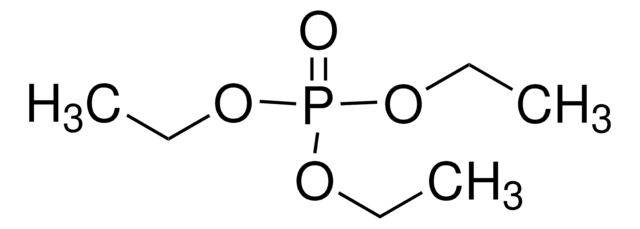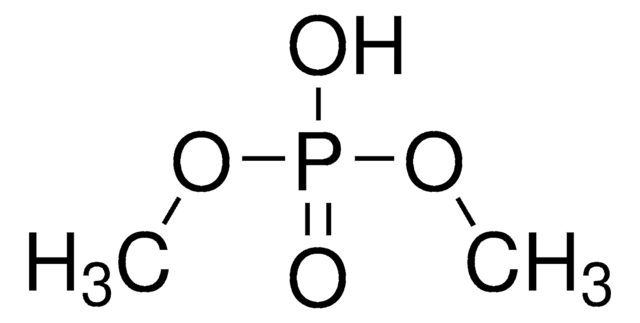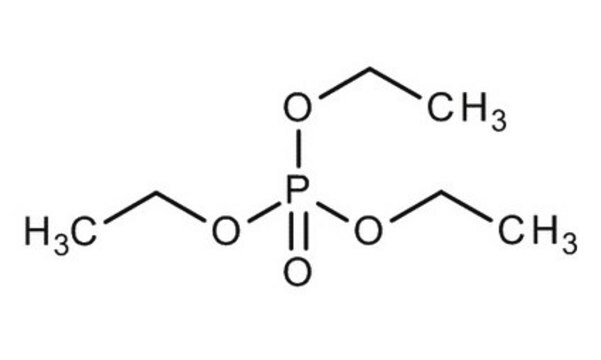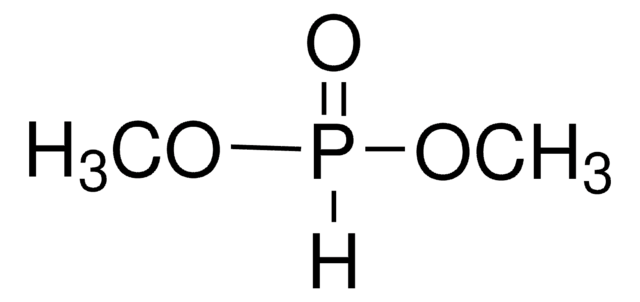8.21184
Trimethyl phosphate
for synthesis
Synonyme(s) :
Trimethyl phosphate
About This Item
Produits recommandés
Pression de vapeur
1.133 hPa ( 25 °C)
Niveau de qualité
Pureté
≥98.0% (GC)
Forme
liquid
Puissance
840 mg/kg LD50, oral (Rat)
3388 mg/kg LD50, skin (Rabbit)
Point d'ébullition
197 °C/1013 hPa
Pf
-46 °C
Température de transition
flash point >150 °C
Solubilité
1000 g/L
Densité
1.21 g/cm3 at 20 °C
Température de stockage
2-30°C
InChI
1S/C3H9O4P/c1-5-8(4,6-2)7-3/h1-3H3
Clé InChI
WVLBCYQITXONBZ-UHFFFAOYSA-N
Application
- Manipulating the ionic conductivity and interfacial compatibility of polymer-in-dual-salt electrolytes: This study explores the role of trimethyl phosphate in enhancing the ionic conductivity and interfacial stability of polymer-in-dual-salt electrolytes, crucial for the development of extended-temperature quasi-solid metal batteries. The research highlights the compound′s effectiveness in improving battery performance across varying temperatures, a key consideration for next-generation energy storage solutions (Lin et al., 2024).
- Concentration levels and ecological risk assessment of typical organophosphate esters in representative surface waters of a megacity: This paper assesses the environmental impact of organophosphate esters, including trimethyl phosphate, in urban water bodies. It presents data on concentration levels and discusses the ecological risks associated with these compounds, providing essential insights for environmental protection and policy-making (Qiao et al., 2024).
- [Screening of organophosphorus flame retardant residues in rice]: Utilizing QuEChERS-gas chromatography-quadrupole time-of-flight mass spectrometry, this study identifies the presence of organophosphorus flame retardants, such as trimethyl phosphate, in rice samples. The research underscores the importance of monitoring agricultural products for chemical residues to ensure food safety (Li et al., 2023).
Remarque sur l'analyse
Density (d 20 °C/ 4 °C): 1.210 - 1.215
Identity (IR): passes test
Mention d'avertissement
Danger
Mentions de danger
Conseils de prudence
Classification des risques
Acute Tox. 4 Oral - Carc. 2 - Eye Irrit. 2 - Muta. 1B - Skin Irrit. 2
Code de la classe de stockage
6.1C - Combustible, acute toxic Cat.3 / toxic compounds or compounds which causing chronic effects
Classe de danger pour l'eau (WGK)
WGK 1
Point d'éclair (°F)
302.0 °F - closed cup
Point d'éclair (°C)
150 °C - closed cup
Certificats d'analyse (COA)
Recherchez un Certificats d'analyse (COA) en saisissant le numéro de lot du produit. Les numéros de lot figurent sur l'étiquette du produit après les mots "Lot" ou "Batch".
Déjà en possession de ce produit ?
Retrouvez la documentation relative aux produits que vous avez récemment achetés dans la Bibliothèque de documents.
Les clients ont également consulté
Notre équipe de scientifiques dispose d'une expérience dans tous les secteurs de la recherche, notamment en sciences de la vie, science des matériaux, synthèse chimique, chromatographie, analyse et dans de nombreux autres domaines..
Contacter notre Service technique








